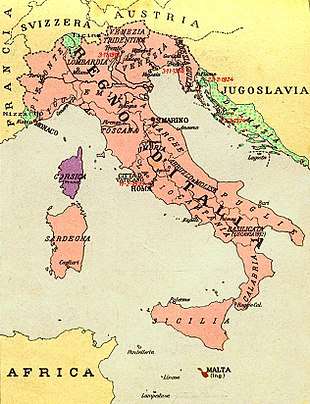Italian irredentism
Italian irredentism (Italian: irredentismo italiano) was a nationalist movement during the late 19th and early 20th centuries in Italy with irredentist goals which promoted the unification of geographic areas in which indigenous peoples considered to be ethnic Italians and/or Italian-speaking individuals formed a majority, or substantial minority, of the population.
Originally, the movement promoted the annexation to Italy of territories inhabited by an Italian indigenous population, but retained by the Austrian Empire after Third Italian War of Independence in 1866. These included Trentino and Trieste, but also multilingual and multiethnic areas within the northern Italian region encompassed by the Alps, with German, Italian, Slovene, Croatian, Ladin and Istro-Romanian population, such as South Tyrol, a part of Istria, Gorizia and Gradisca and part of Dalmatia. The claims were extended later to the city of Fiume, Corsica, the island of Malta, the County of Nice and Italian Switzerland.
During the period of Risorgimento in 1860 to 1861, Prime Minister of Piedmont-Sardinia, Camillo Benso, Count of Cavour who was leading the Risorgimento effort, faced the view of French Emperor Napoleon III who indicated that France would support militarily the Italian unification provided that France was given Nice and Savoy that were held by Piedmont-Sardinia, as France did not want a powerful state having control of the passages of the Alps.[1] As a result, Piedmont-Sardinia was pressured to cede Nice and Savoy to France in exchange for France accepting and sending troops to help the unification of Italy.[2]
To avoid confusion and in line with convention, this article uses modern English place names throughout. However, most places have alternative names in Italian. See List of Italian place names in Dalmatia.
Characteristics
Italian irredentism was not a formal organization but rather an opinion movement, advocated by several different groups, claiming that Italy had to reach its "natural borders" or unify territories inhabited by Italians. Similar nationalistic ideas were common in Europe in the late 19th century. The term "irredentism", coined from the Italian word, came into use in many countries (see List of irredentist claims or disputes). This idea of Italia irredenta is not to be confused with the Risorgimento, the historical events that led to irredentism, nor with nationalism or Imperial Italy, the political philosophy that took the idea further under fascism.
Irredentism in Italy originated as a consequence of the French expansion in Italy that started with the annexation of Corsica in 1768[3] and was followed by Napoleon's inclusion – inside the territories of France's First French Empire – of the regions of Piedmont, Liguria and Tuscany. The Corsican revolutionary Pasquale Paoli was called "the precursor of Italian irredentism" by Niccolò Tommaseo because he was the first to promote the Italian language and socio-culture (the main characteristics of Italian irredentism) in his island; Paoli wanted the Italian language to be the official language of the newly founded Corsican Republic.
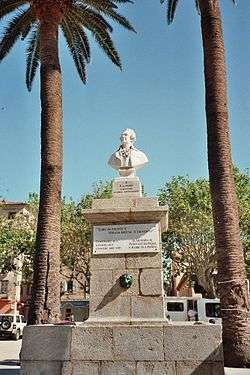
Pasquale Paoli's appeal in 1768 against the French invader said:
We are Corsicans by birth and sentiment, but first of all we feel Italian by language, origins, customs, traditions; and Italians are all brothers and united in the face of history and in the face of God ... As Corsicans we wish to be neither slaves nor "rebels" and as Italians we have the right to deal as equals with the other Italian brothers ... Either we shall be free or we shall be nothing... Either we shall win or we shall die (against the French), weapons in hand ... The war against France is right and holy as the name of God is holy and right, and here on our mountains will appear for Italy the sun of liberty
— Pasquale Paoli[4]
Paoli's Corsican Constitution of 1755 was written in Italian and the short-lived university he founded in the city of Corte in 1765 used Italian as the official language.
During the 19th century, the Italian irredentism fully developed the characteristic of defending the Italian language from other people's languages like, for example, German in Switzerland and in the Austro-Hungarian Empire or French in Nice and Corsica.
The liberation of Italia irredenta was perhaps the strongest motive for Italy's entry into World War I and the Treaty of Versailles in 1919 satisfied many irredentist claims.[5]
Italian irredentism has the characteristic of being originally moderate, requesting only the return to Italy of the areas with Italian majority of population,[6] but after World War I it became aggressive – under fascist influence – and claimed to the Kingdom of Italy even areas where Italians were minority or had been present only in the past. In the first case there were the Risorgimento claims on Trento, while in the second there were the fascist claims on the Ionian Islands, Savoy and Malta.
Origins
After the Italian unification and Third Italian War of Independence in 1866, there were areas with Italian-speaking communities within the borders of several countries around the newly created Kingdom of Italy. The irredentists sought to annex all those areas to the newly unified Italy. The areas targeted were Corsica, Dalmatia, Gorizia, the Ionian islands, Istria, Malta, County of Nice, Ticino, small parts of Grisons and of Valais, Trentino, Trieste and Fiume.
Different movements or groups born in this period: in 1877 the Italian politician Matteo Renato Imbriani invented the new term terre irredente ("unredeemed lands"); in the same year the movement Associazione in pro dell'Italia Irredenta ("Association for the Unredeemed Italy") was founded; in the 1885 was founded the Pro Patria movement ("For Fatherland") and in 1891 the Lega Nazionale Italiana ("Italian National League") was founded in Trento and Trieste (in the Austrian Empire).
Initially, the movement can be described as part of the more general nation-building process in Europe in the 19th and 20th centuries when the multi-national Austro-Hungarian, Russian and Ottoman Empires were being replaced by nation-states. The Italian nation-building process can be compared to similar movements in Germany (Großdeutschland), Hungary, Serbia and in pre-1914 Poland. Simultaneously, in many parts of 19th century Europe liberalism and nationalism were ideologies which were coming to the forefront of political culture. In Eastern Europe, where the Habsburg Empire had long asserted control over a variety of ethnic and cultural groups, nationalism appeared in a standard format. The beginning of the 19th century "was the period when the smaller, mostly indigenous nationalities of the empire – Czechs, Slovaks, Slovenes, Croats, Serbs, Ukrainians, Romanians – remembered their historical traditions, revived their native tongues as literary languages, reappropriated their traditions and folklore, in short reasserted their existence as nations".[7] The notion of a single united Italy was related to the aspirations of the "majority populations".
19th century
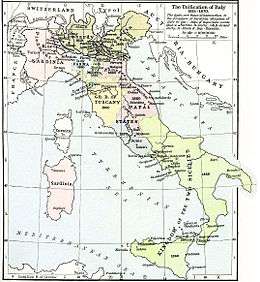
A precursor of the "irredentists" was the unification leader Giuseppe Garibaldi, who in 1859 as deputy for his native Nice in the Piedmontese parliament at Turin attacked Cavour for ceding Nice to Napoleon III in order to get French help and approval for Italian Unification. Irredentism grew in importance in Italy in the next years.
On 21 July 1878, a noisy public meeting was held at Rome with Menotti Garibaldi, the son of Giuseppe Garibaldi, as chairman of the forum and a clamour was raised for the formation of volunteer battalions to conquer the Trentino. Benedetto Cairoli, then Prime Minister of Italy, treated the agitation with tolerance.[8]
However, it was mainly superficial, as most Italians did not wish a dangerous policy against Austria and even less against France for the sake of Nice and Corsica, or against Britain for Malta.[8]
One consequence of irredentist ideas outside of Italy was an assassination plot organized against the Emperor Francis Joseph in Trieste in 1882, which was detected and foiled.[8] Guglielmo Oberdan, a Triestine and thus Austrian citizen, was executed. When the irredentist movement became troublesome to Italy through the activity of Republicans and Socialists, it was subject to effective police control by Agostino Depretis.[8]
Irredentism faced a setback when the French occupation of Tunisia in 1881 started a crisis in French–Italian relations. The government entered into relations with Austria and Germany, which took shape with the formation of the Triple Alliance in 1882.
The irredentists' dream of absorbing the targeted areas into Italy made no further progress in the 19th century, as the borders of the Kingdom of Italy remained unchanged and the Rome government began to set up colonies in Eritrea and Somalia in Africa.
World War I
See also: Italian entry into World War I and Italy in World War I – from neutrality to intervention
Italy signed the London Pact and entered World War I with the intention of gaining those territories perceived by irredentists as being Italian under foreign rule. According to the pact, Italy was to leave the Triple Alliance and join the Entente Powers. Furthermore, Italy was to declare war on Germany and Austria-Hungary within a month. The declaration of war was duly published on 23 May 1915.[9] In exchange, Italy was to obtain various territorial gains at the end of the war. In April 1918, in what he described as an open letter "to the American Nation" Paolo Thaon di Revel, Commander in Chief of the Italian navy, appealed to the people of the United States to support Italian territorial claims over Trento, Trieste, Istria, Dalmatia and the Adriatic, writing that "we are fighting to expel an intruder from our home".[10]
The outcome of the First World War and the consequent settlement of the Treaty of Saint-Germain met some Italian claims, including many (but not all) of the aims of the Italia irredenta party.[11] Italy gained Trieste, Gorizia, Istria and the city of Zara. In Dalmatia, despite the Treaty of London, only territories with Italian majority as Zadar (Zara) with some Dalmatian islands, such as Cres (Cherso), Lošinj (Lussino) and Lastovo (Lagosta) were annexed by Italy because Woodrow Wilson, supporting Yugoslav claims and not recognizing the treaty, rejected Italian requests on other Dalmatian territories.
The city of Rijeka (Fiume) in the Kvarner was the subject of claim and counter-claim because it had an Italian majority, but Fiume had not been promised to Italy in the London Pact, though it was to become Italian by 1924 (see Italian Regency of Carnaro, Treaty of Rapallo, 1920 and Treaty of Rome, 1924).
The stand taken by the irredentist Gabriele D'Annunzio, which briefly led him to become an enemy of the Italian state,[12] was meant to provoke a nationalist revival through corporatism (first instituted during his rule over Fiume), in front of what was widely perceived as state corruption engineered by governments such as Giovanni Giolitti's.
D'Annunzio briefly annexed to this "Regency of Carnaro" even the Dalmatian islands of Krk (Veglia) and Rab (Arbe), where there was a numerous Italian community.
Fascism and World War II
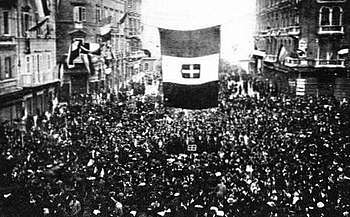

Fascist Italy strove to be seen as the natural result of war heroism against a "betrayed Italy" that had not been awarded all it "deserved", as well as appropriating the image of Arditi soldiers. In this vein, irredentist claims were expanded and often used in Fascist Italy's desire to control the Mediterranean basin. To the east of Italy, the Fascists claimed that Dalmatia was a land of Italian culture whose Italians, including those of Italianized South Slavic descent, had been driven out of Dalmatia and into exile in Italy, and supported the return of Italians of Dalmatian heritage.[13] Mussolini identified Dalmatia as having strong Italian cultural roots for centuries via the Roman Empire and the Republic of Venice.[14] The Fascists especially focused their claims based on the Venetian cultural heritage of Dalmatia, claiming that Venetian rule had been beneficial for all Dalmatians and had been accepted by the Dalmatian population.[14] The Fascists were outraged after World War I, when the agreement between Italy and the Entente Allies in the Treaty of London of 1915 to have Dalmatia join Italy was revoked in 1919.[14]
To the west of Italy, the Fascists claimed that the territories of Corsica, Nice and Savoy held by France were Italian lands.[15][16] The Fascist regime produced literature on Corsica that presented evidence of the island's italianità.[17] The Fascist regime produced literature on Nice that justified that Nice was an Italian land based on historic, ethnic and linguistic grounds.[17] The Fascists quoted Medieval Italian scholar Petrarch who said: "The border of Italy is the Var; consequently Nice is a part of Italy".[17] The Fascists quoted Italian national hero Giuseppe Garibaldi, a native of Nizza (Nice) himself, who said: "Corsica and Nice must not belong to France; there will come the day when an Italy mindful of its true worth will reclaim its provinces now so shamefully languishing under foreign domination".[17] Mussolini initially pursued promoting annexation of Corsica through political and diplomatic means, believing that Corsica could be annexed to Italy through Italy first encouraging the existing autonomist tendencies in Corsica and then independence of Corsica from France, that would be followed by annexation of Corsica into Italy.[18]
In 1923, Mussolini temporarily occupied Corfu, using irredentist claims based on minorities of Italians in the Ionian islands of Greece. Similar tactics may have been used towards the islands around the Kingdom of Italy – through the pro-Italian Maltese, Corfiot Italians and Corsican Italians – in order to control the Mediterranean sea (his Mare Nostrum, from the Latin "Our Sea").
During World War II, large parts of Dalmatia were annexed by Italy into the Governorship of Dalmatia from 1941 to 1943. Corsica and Nice were also administratively annexed by Italy in November 1942. Malta was heavily bombed, but was not occupied due to Erwin Rommel's request of diverting to North Africa the forces that had been prepared for the invasion of the island.
Dalmatia
The Italian linguist Matteo Bartoli calculated that Italian was the primary spoken language by almost 30% of the Dalmatian population at the beginning of the Napoleonic wars.[19] Bartoli's evaluation was followed by other claims: Auguste de Marmont, the French Governor General of the Napoleonic Illyrian Provinces commissioned a census in 1814–1815 which found that Dalmatian Italians comprised 25% of the total population of Dalmatia. Accordingly, three years later an Austrian census found around 70,000 Italians in a total of 301,000 people living in Austrian Dalmatia.[20]
With the development of Croatian nationalism, critics such as Croatian historian Duško Večerina alleged that these evaluations were not conducted by modern scientific standards and that they took spoken language as the criterion, rather than blood, origin and ethnicity. They pointed out that according to a report by Imperial court councillor Joseph Fölch in 1827, the Italian language was spoken by noblemen and some citizens of middle and lower classes exclusively in the coastal cities of Zadar, Šibenik and Split. Since only around 20,000 people populated these towns and not all were Italian speakers, they claim that the real number was rather smaller, probably around 7% of the total population, as is asserted by the Department of Historical Studies of the Croatian Academy of Sciences and Arts (HAZU).[21]
Not only Italian irredentists (like Gabriele D'Annunzio) but also Italian prominent scholars (like Angelo Vivante) alleged that Joseph Fölch did not include the Dalmatian islands of Cres (Cherso), Lošinj (Lussino), Krk (Veglia), Vis (Lissa), Hvar (Lesina), Korcula (Curzola) and many others islands with significant Italian communities and so in their opinion Folch did only a partial and mistaken estimate of the real number of the Dalmatian Italians. They reasserted that the only official evidence about the Dalmatian population comes from the 1857 Austro-Hungarian census, which showed that in this year there were 369,310 indigenous Croatians and 45,000 Italians in Dalmatia,[22] making Dalmatian Italians 17% of the total population of Dalmatia in the mid-19th century.
Dalmatia was a strategic region during World War I that both Italy and Serbia intended to seize from Austria-Hungary. Italy joined the Triple Entente Allies in 1915 upon agreeing to the London Pact that guaranteed Italy the right to annex a large portion of Dalmatia in exchange for Italy's participation on the Allied side. From 5–6 November 1918, Italian forces were reported to have reached Vis, Lastovo, Šibenik, and other localities on the Dalmatian coast.[23] By the end of hostilities in November 1918, the Italian military had seized control of the entire portion of Dalmatia that had been guaranteed to Italy by the London Pact and by 17 November had seized Fiume as well.[24] In 1918, Admiral Enrico Millo declared himself Italy's Governor of Dalmatia.[24] Famous Italian nationalist Gabriele d'Annunzio supported the seizure of Dalmatia and proceeded to Zadar in an Italian warship in December 1918.[25]
The last city with a significant Italian presence in Dalmatia was the city of Zadar. In the Habsburg empire census of 1910, the city of Zadar had an Italian population of 9,318 (or 69.3% out of the total of 13,438 inhabitants). Zadar's population grew to 24,100 inhabitants, of which 20,300 were Italians, when in 1942 it was the capital of the Governorate of Dalmatia (the "Governorate" fulfilled the aspirations of Italian irredentism in the Adriatic).
In 1943, Josip Broz Tito informed the Allies that Zadar was a chief logistic centre for German forces in Yugoslavia. By overstating its importance, he persuaded them of its military significance. Italy surrendered in September 1943 and over the following year, specifically between 2 November 1943 and 31 October 1944, Allied Forces bombarded the town fifty-four times.
Nearly 2,000 people were buried beneath rubble: 10–12,000 people escaped and took refuge in Trieste and slightly over 1,000 reached Apulia.
Tito's partisans entered Zadar on 31 October 1944 and 138 people were killed.[26] With the Peace Treaty of 1947, Italians still living in Zadar followed the Italian exodus from Dalmatia and only about 100 Dalmatian Italians now remain in the city.
Post-World War II
After World War II, Italian Irredentism diminished along with the defeated Fascists and the Monarchy of the House of Savoy. After the Treaty of Paris (1947) and the Treaty of Osimo (1975), all territorial claims were abandoned by the Italian State (see Foreign relations of Italy). Today, Italy, France, Malta, Greece, Croatia and Slovenia are all members of the European Union, while Montenegro and Albania are candidates for accession.
The often cited the then-Italian Deputy Gianfranco Fini, who in Senigallia in 2004 gave an interview to the Slobodna Dalmacija daily newspaper at the 51st gathering of the Italians who left Yugoslavia after World War II, in which he was reported to have said: "From the son of an Italian from Fiume I learned that those areas were and are Italian, but not because at any particular historical moment our army planted Italians there. This country was Venetian, and before that Roman".[27] Rather than issuing an official rebuttal of those words, Carlo Giovanardi, then Parliamentary Affairs Minister in Berlusconi's government, affirmed Fini's words by saying "that he told the truth".[28]
These sources pointed out that on the 52nd gathering of the same association, in 2005, Carlo Giovanardi was quoted by the Večernji list daily newspaper as saying that Italy would launch a cultural, economic and touristic invasion in order to restore "the Italianness of Dalmatia" while participating in a roundtable discussion on the topic "Italy and Dalmatia today and tomorrow".[29] Giovanardi later declared that he had been misunderstood[30] and sent a letter to the Croatian Ministry of Foreign Affairs in which he condemned nationalism and ethnic strife.[31]
They underlined that Alleanza Nazionale (a former Italian conservative party) derived directly from the Italian Social Movement (MSI), a neo-fascist party. In 1994, Mirko Tremaglia, a member of the MSI and later of Alleanza Nazionale, described Rijeka, Istria and Dalmatia as "historically Italian" and referred to them as "occupied territories", saying that Italy should "tear up" the 1975 Treaty of Osimo with the former Yugoslavia and block Slovenia and Croatia's accession to European Union membership until the rights of their Italian minorities were respected.[32]
In 2001, Italian president Carlo Azeglio Ciampi gave the golden medal (for the aerial bombings endured during World War II) to the last Italian administration of Zadar (Zara in Italian), represented by its Gonfalone, owned by the association "Free municipality of Zara in exile". Croatian authorities complained that he was awarding a fascist institution, even if the motivations for the golden medal explicitly recalled the contribution of the city to the Resistance against Fascism. The motivations were contested by several Italian right-wing associations, such as the same "Free municipality of Zara in exile" and the Lega Nazionale.[33]
On 12 December 2007, the Italian post office issued a stamp with a photo of the Croatian city of Rijeka and with the text "Fiume – eastern land once part of Italy" ("Fiume-terra orientale già italiana").[34][35] Some Croatian sources affirmed that "già italiana" could also mean "already Italian", even if according to Italian syntaxis the correct meaning in this case is only "previously Italian". 3.5 million copies of the stamp were printed , but it was not delivered by the Italian Post Office in order to forestall a possible diplomatic crisis with Croatian and Slovenian authorities . Nevertheless, some of the stamps leaked out and came in official use, and it became widely known.
Political figures in Italian irredentism
Regions historically claimed by Italian irredentism
- Istria


- Dalmatia

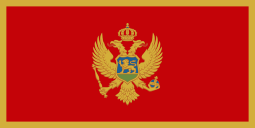
- Monaco

- Nice province

- Corsica

- Savoy

- Malta
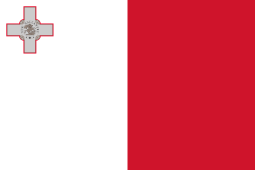
- Ionian Islands

- Canton Ticino, parts of Canton Vallese and Italian Graubünden

- San Marino
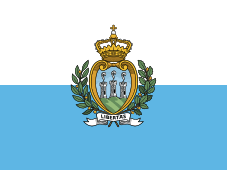
- Coastal parts of Vlorë region and Vlorë

- Palagruža

See also
- Kingdom of Italy
- Istrian exodus
- Italian Empire
- Italian geographical region
- Italian Regency of Carnaro
- Italian Unification
References
Citations
- Adda Bruemmer Bozeman. Regional Conflicts Around Geneva: An Inquiry Into the Origin, Nature, and Implications of the Neutralized Zone of Savoy and of the Customs-free Zones of Gex and Upper Savoy. P. 196.
- Adda Bruemmer Bozeman. Regional Conflicts Around Geneva: An Inquiry Into the Origin, Nature, and Implications of the Neutralized Zone of Savoy and of the Customs-free Zones of Gex and Upper Savoy. Stanford, California, USA: Stanford University Press, 1949. P. 196.
- Italian Corsica
- N. Tommaseo. "Lettere di Pasquale de Paoli" (in Archivio storico italiano, 1st series, vol. XI).
- irredentism Archived 2008-05-10 at the Wayback Machine – The Columbia Encyclopedia, Sixth Edition. 2001–07
- NYTimes on Italian irredentism in Istria
- Sperber, Jonathan. The European Revolutions, 1848–1851. New York: Cambridge University Press, 2005. page 99.
- Chisholm, Hugh, ed. (1911). . Encyclopædia Britannica. 14 (11th ed.). Cambridge University Press. p. 840.
- 11 NATIONS NOW INVOLVED IN WAR; Washington Expects Rumania, Bulgaria, and Greece Soon to Join the Allies. TRADE PROBLEMS CREATED Switzerland, Now Isolated, Must Look to Italy for Means to Get in Supplies. 11 NATIONS NOW INVOLVED IN WAR May 24, 1915, Monday Page 1, 749 words – The New York Times
- Italy's Navy Chief Explains Italian Claims; Trent,...(14 April 1918) – The New York Times
- ITALY'S PRICE FOR NEUTRALITY (28 March 1915) – The New York Times
- Stato Libero Di Fiume Archived 2007-12-22 at the Wayback Machine – (English: "Free State Of Fiume")
- Jozo Tomasevich. War and Revolution in Yugoslavia 1941–1945: Occupation and Collaboration. Stanford, California, USA: Stanford University Press, 2001. P. 131.
- Larry Wolff. Venice And the Slavs: The Discovery of Dalmatia in the Age of Enlightenment. Stanford, California, USA: Stanford University Press, P. 355.
- Aristotle A. Kallis. Fascist Ideology: Expansionism in Italy and Germany 1922–1945. London, England; UK; New York, New York, USA: Routledge, 2000. P. 118.
- Mussolini Unleashed, 1939–1941: Politics and Strategy in Fascist Italy's Last War. Cambridge, England, UK: Cambridge University Press, 1986, 1999. P. 38.
- Davide Rodogno. Fascism's European Empire: Italian Occupation during the Second World War. Cambridge, England, UK: Cambridge University Press, 2006. P. 88.
- John Gooch. Mussolini and his Generals: The Armed Forces and Fascist Foreign Policy, 1922–1940. Cambridge, England, UK: Cambridge University Press, 2007. Pp. 452.
- Bartoli, Matteo. Le parlate italiane della Venezia Giulia e della Dalmazia. p.46
- Italian irredentism in Dalmatia
- O broju Talijana/Talijanaša u Dalmaciji XIX. Stoljeća”, Zavod za povijesne znanosti HAZU u Zadru, 2002, UDK 949.75:329.7”19”Dalmacija 2002, p. 344
(“Concerning the number of Italians/pro-Italians in Dalmatia in the 19th century”) See http://hrcak.srce.hr/index.php?show=clanak&id_clanak_jezik=18696 - Statistisches Handbüchlein für die Oesterreichische Monarchie Page 38 – Von Direction der Administrativen Statistik, Österreich – Veröffentlicht 1861
- Giuseppe Praga, Franco Luxardo. History of Dalmatia. Giardini, 1993. Pp. 281.
- Paul O'Brien. Mussolini in the First World War: the Journalist, the Soldier, the Fascist. Oxford, England, UK; New York, New York, USA: Berg, 2005. Pp. 17.
- A. Rossi. The Rise of Italian Fascism: 1918–1922. New York, New York, USA: Routledge, 2010. Pp. 47.
- Lovrovici, don Giovanni Eleuterio. Zara dai bombardamenti all'esodo (1943–1947) Tipografia Santa Lucia – Marino. Roma, 1974. p. 66.
- Slobodna Dalmacija Gianfranco Fini: "Dalmacija, Rijeka i Istra oduvijek su talijanske zemlje", October 13, 2004.
("Dalmatia, Rijeka and Istria are ancient Italian lands") See http://arhiv.slobodnadalmacija.hr/20041013/temedana01.asp - Slobodna Dalmacija Davorin Rudolf: Utroba koja je porodila talijanski iredentizam još uvijek je plodna, Mar 18, 2006
(The bowels that gave birth to Italian irrendentism are still fertile) - Nacional Archived 2013-02-17 at Archive.today Talijanski ministar najavio invaziju na Dalmaciju, Oct 19, 2005 ("Italian minister announced an invasion on Dalmatia")
- "Veleni nazionalisti sulla casa degli italiani" su Corriere della Sera del 21/10/2005 ("Nationalist poisons on the house of Italians") archiviostampa.it
- CROATIA "We Are Ready to Invade Dalmatia" Italian minister says Archived 2011-07-15 at the Wayback Machine – 24/10/2005 – Pioneer Investors
- Italian Coalition Trips on Old Yugoslavia Issue By JOHN TAGLIABUE, Published: Monday, April 25, 1994 – New York Times
- Lega Nazionale Medaglia d'oro al comune di Zara ("Golden Medal to the Municipality of Zadar")
- (in Croatian) Index.hr MVP uputio prosvjednu notu Italiji zbog poštanske marke s nacionalističkim natpisom
(The Croatian Ministry of Foreign Affairs has sent a protest note to Italy, because of issue of a stamp with nationalistic text) - B92 – Internet, Radio and TV station Archived 2011-06-08 at the Wayback Machine Zagreb protests over Italian stamp
Sources
- Bartoli, Matteo. Le parlate italiane della Venezia Giulia e della Dalmazia. Tipografia italo-orientale. Grottaferrata. 1919.
- Colonel von Haymerle, Italicae res, Vienna, 1879 – the early history of irredentists.
- Lovrovici, don Giovanni Eleuterio. Zara dai bombardamenti all'esodo (1943–1947). Tipografia Santa Lucia – Marino. Roma. 1974.
- Petacco, Arrigo. A tragedy revealed: the story of Italians from Istria, Dalmatia, Venezia Giulia (1943–1953). University of Toronto Press. Toronto. 1998.
- Večerina, Duško. Talijanski Iredentizam ("Italian Irredentism"). ISBN 953-98456-0-2. Zagreb. 2001.
- Vivante, Angelo. Irredentismo adriatico ("The Adriatic Irredentism"). 1984.
External links
- Unredeemed Italy (Google Book)
- Articles on the History of Dalmatia
- Articles on the Italians in Dalmatia
- Articles on Zadar, when was a city of the Kingdom of Italy.
- Slovene – Italian relations between 1880–1918
- (in Italian) Movimento irredentista italiano Italian irredentist movement
- (in Croatian) Hrvati AMAC Gdje su granice (EU-)talijanskog bezobrazluka? (Where are the limits of Italian arrogancy?; page contains the speech of Italian deputy)
- (in Croatian) Slobodna Dalmacija Počasni građanin Zadra kočnica talijanskoj ratifikaciji SSP-a
- (in Italian) D'Annunzio and Rijeka
- (in Italian) Politicamentecorretto.com Guglielmo Picchi Forza Italia
- (in Italian) Italia chiama Italia Francobollo Fiume: bloccata l'emissione
- (in Italian) Trieste.rvnet.eu Stoppato il francobollo per Fiume, bufera: protestano Unione degli istriani, An e Forza Italia (contains the scan of the stamp)
